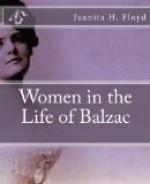Madame Kisseleff was one of Madame Hanska’s friends whom he probably met in Vienna; he dined at her home frequently and enjoyed her company, for she could talk to him of his Louloup. She was a friend of Madame Hamelin, and moved to Fontainebleu to be near her while the latter was living at La Madeleine. While living in Paris, Madame Kisseleff entertained Madame Hamelin and several other ladies together with Balzac; these dinners and his visites de digestion caused him to see much of her for awhile, but as in many of his other friendships, his ardor cooled later, and he went to her home only when specially invited. In 1844, she left Paris to reside at Homburg where she built a house. The novelist took advantage of her friendship to send articles to Madame Hanska through the Russian ambassador.
Balzac made visites de politesse to the Princesse de Schonburg, an acquaintance of Madame Hanska’s, but no more than were required by courtesy. It would have been convenient for him to have seen much of her, had he cared to, for she had placed her child in the same house with him on account of its vicinity to the orthopaedic hospital.
One of Madame Hanska’s friends whom Balzac liked was Madame Jaroslas Potocka, sister of the Countess Schouwaloff. She wrote some very pleasing letters to him, but he was too busy to answer them, so he sent her messages, or enclosed notes to her in his letters to his Predilecta.
La Baronne de Pfaffins, nee Comtesse Mierzciewska, was a Polish lady whom Balzac met rather late in life. He first thought she was Madame Hanska’s cousin, but later learned that it was to M. de Hanski that she was related. Her Polish voice reminded him so much of his Louloup that he was moved to tears; this friendship, however, did not continue long.
Another acquaintance from the land of Balzac’s “Polar Star” was Madame Delphine Potocka who was a great friend of Chopin, to whom he dedicated some of his happiest inspirations, and whose voice he so loved that he requested her to sing while he was dying. Her box at the opera was near Balzac’s so that he saw her frequently, and dined with her, but did not admire her.
MARIA—HELENE—LOUISE
“To Maria:
“May your name, that of one whose portrait is the noblest ornament of this work, lie on its opening page like a branch of sacred box, taken from an unknown tree, but sanctified by religion, and kept ever fresh and green by pious hand to protect the home.
“DE BALZAC.”
Just who is the “Maria” to whom the dedication of Eugenie Grandet is addressed is a question that in the opinion of the present writer has never been satisfactorily answered. The generally accepted answer is that of Spoelberch de Lovenjoul, who thought that “Maria” was the girl whom Balzac described as a “poor, simple and delightful bourgeoise, . . . the most naive creature that ever was, fallen like a flower from heaven,” and who said to Balzac: “Love me a year, and I will love you all my life.”




